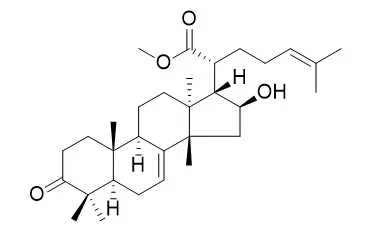| In vitro: |
| PLoS One. 2015 Oct 20;10(10):e0141272. | | Limonoids from Melia azedarach Fruits as Inhibitors of Flaviviruses and Mycobacterium tubercolosis.[Pubmed: 26485025] | The biological diversity of nature is the source of a wide range of bioactive molecules. The natural products, either as pure compounds or as standardized plant extracts, have been a successful source of inspiration for the development of new drugs.
The present work was carried out to investigate the cytotoxicity, antiviral and antimycobacterial activity of the methanol extract and of four identified limonoids from the fruits of Melia azedarach (Meliaceae).
METHODS AND RESULTS:
The extract and purified limonoids were tested in cell-based assays for antiviral activity against representatives of ssRNA, dsRNA and dsDNA viruses and against Mycobacterium tuberculosis. Very interestingly, 3-α-tigloyl-melianol and melianone showed a potent antiviral activity (EC50 in the range of 3-11μM) against three important human pathogens, belonging to Flaviviridae family, West Nile virus, Dengue virus and Yellow Fever virus. Mode of action studies demonstrated that title compounds were inhibitors of West Nile virus only when added during the infection, acting as inhibitors of the entry or of a very early event of life cycle. Furthermore, 3-α-tigloyl-melianol and Methyl kulonate showed interesting antimycobacterial activity (with MIC values of 29 and 70 μM respectively). The limonoids are typically lipophilic compounds present in the fruits of Melia azeradach. They are known as cytotoxic compounds against different cancer cell lines, while their potential as antiviral and antibacterial was poorly investigated.
CONCLUSIONS:
Our studies show that they may serve as a good starting point for the development of novel drugs for the treatment of infections by Flaviviruses and Mycobacterium tuberculosis, for which there is a continued need. | | Chem Biodivers. 2014 Aug;11(8):1121-39. | | Cytotoxic and nitric oxide production-inhibitory activities of limonoids and other compounds from the leaves and bark of Melia azedarach.[Pubmed: 25146759 ] | Nine limonoids, 1-9, one apocarotenoid, 11, one alkaloid, 12, and one steroid, 13, from the leaf extract; and one triterpenoid, 10, five steroids, 14-18, and two flavonoids, 19 and 20, from the bark extract of Melia azedarach L. (Chinaberry tree; Meliaceae) were isolated.
METHODS AND RESULTS:
Among these compounds, three compounds, 4-6, were new, and their structures were established as 3-deacetyl-28-oxosalannolactone, 3-deacetyl-28-oxosalanninolide, and 3-deacetyl-17-defurano-17,28-dioxosalannin, respectively, on the basis of extensive spectroscopic analyses and comparison with literature data. All of the isolated compounds were evaluated for their cytotoxic activities against leukemia (HL60), lung (A549), stomach (AZ521), and breast (SK-BR-3) cancer cell lines. 3-Deacetyl-4'-demethyl-28-oxosalannin (3) against HL60 and AZ521 cells, and Methyl kulonate (10) against HL60 cells exhibited potent cytotoxicities with IC50 values in the range of 2.8-5.8 μM. In addition, upon evaluation of compounds 1-13 against production of nitric oxide (NO) in mouse macrophage RAW 264.7 cells induced by lipopolysaccharide (LPS), seven, i.e., trichilinin B (1), 4, ohchinin (7), 23-hydroxyohchininolide (8), 21-hydroxyisoohchininolide (9), 10, and methyl indole 3-carboxylate (12), inhibited production of NO with IC50 values in the range of 4.6-87.3 μM with no, or almost no, toxicity to the cells (IC50 93.2-100 μM).
CONCLUSIONS:
Western blot analysis revealed that compound 7 reduced the expression levels of the inducible NO synthase (iNOS) and COX-2 proteins in a concentration-dependent manner. Furthermore, compounds 5, 6, 13, and 18-20 exhibited potent inhibitory effects (IC50 299-381 molar ratio/32 pmol TPA) against Epstein-Barr virus early antigen (EBV-EA) activation induced by 12-O-tetradecanoylphorbol-13-acetate (TPA) in Raji cell line. |
|






 Cell. 2018 Jan 11;172(1-2):249-261.e12. doi: 10.1016/j.cell.2017.12.019.IF=36.216(2019)
Cell. 2018 Jan 11;172(1-2):249-261.e12. doi: 10.1016/j.cell.2017.12.019.IF=36.216(2019) Cell Metab. 2020 Mar 3;31(3):534-548.e5. doi: 10.1016/j.cmet.2020.01.002.IF=22.415(2019)
Cell Metab. 2020 Mar 3;31(3):534-548.e5. doi: 10.1016/j.cmet.2020.01.002.IF=22.415(2019) Mol Cell. 2017 Nov 16;68(4):673-685.e6. doi: 10.1016/j.molcel.2017.10.022.IF=14.548(2019)
Mol Cell. 2017 Nov 16;68(4):673-685.e6. doi: 10.1016/j.molcel.2017.10.022.IF=14.548(2019)